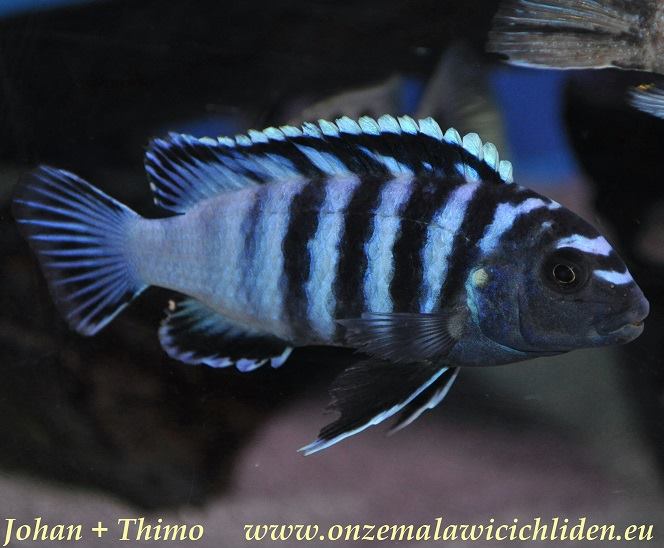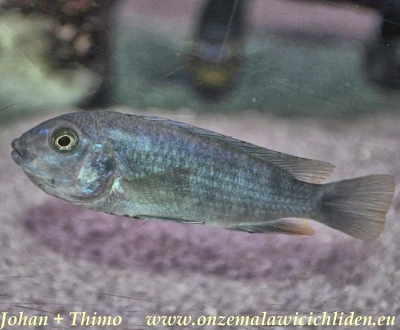
Chindongo minutus, a wild-caught male specimen reportedly from Ruarwe, Malawi. Photo © by Johan Groffen; used by permission. |
Chindongo minutus (Fryer, 1956)
by Michael K. Oliver, Ph.D.
The attractive

Chindongo minutus (female), reportedly captured at Ruarwe. Photo © by Johan Groffen; used by permission. |
Although it was formally described over 60 years ago, very little information has been published in the scientific literature about C. minutus.
The type locality of Chindongo minutus is Nkhata Bay, on the western shore of the lake in its northern region. The geographic limits of its range are not known with any precision, but it also occurs north of Nkhata Bay at Lions Cove, and still further north at Ruarwe (the reported site of capture of the male and female in the accompanying color photos), both localities on the northwest shore. Several similar, but perhaps specifically distinct, populations are found all along the eastern shore of Lake Malawi, differing from west shore representatives primarily in details of coloration. None of these various east shore forms have been scientifically studied in detail, described, and named up to now.
As its species name makes clear, C. minutus is a relatively very small cichlid, reaching a known total length of less than 7 cm (2¾ inches). Like the other mbuna species assigned to the recently (2016) described genus Chindongo, C. minutus has bicuspid teeth in the outer rows of the jaws and these outer teeth are noticeably — about 4 to 10 times — larger and longer than the (tricuspid) teeth of the inner rows. This contrasts with the situation in species currently assigned to Pseudotropheus, whose bicuspid outer teeth are only about twice the size of the inner ones.
Male C. minutus individuals resemble a small BB morph (barred blue) Maylandia zebra. Unfortunately, the generic distinction between Chindongo and Maylandia is a rather unimpressive feature of the skull, and cannot be seen externally in a living fish. (The angle between two skull bones, the vomer and the parasphenoid, is a bit steeper in Chindongo.)
This species has sometimes been exported to the aquarium trade; it is perhaps more often seen in Europe. It makes a desirable aquarium fish, in the hands of an aquarist with adequate experience in maintaining belligerent mbuna and in a tank with plenty of space and hiding places.
The photos below show some of the original type material of this species, housed in The Natural History Museum (London).

Chindongo minutus: four of the paratypes, showing some of the range of variation in Fryer's original material. Photo © by M.K. Oliver. |

Chindongo minutus: closeup of one paratype. Photo © by M.K. Oliver. |
